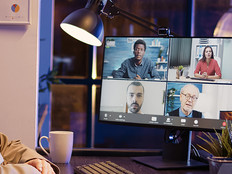I'll Be Seeing You

At Ellison Technologies, one of the largest machine tool distributors and automation integrators in North America, videoconferences are no longer point-to-point ISDN transmissions rife with visual hiccups, such as participants moving with a jerk and a shudder.
Gone, too, are connection charges of 10 to 15 cents per minute and poor audio quality that distracts participants and muddles the meeting. As the technology improved over the past two years, videoconferences have become more commonplace, according to Jeff Hansen, director of IT for the Santa Fe Springs, Calif., company.
“It’s not just an executive thing now,” Hansen says. On the contrary, officials and staff at all levels are meeting this way.
Video over IP has overhauled the look and feel of yesterday’s videoconferences, and companies such as Ellison find they can cut travel costs by swapping out some or all face-to-face meetings for virtual meetings. There are nonfinancial benefits as well.
“People are trying to apply technology to regain the human element of communication,” says Jim Frey, a senior analyst at Enterprise Management Associates, a Boulder, Colo., consulting firm. “Today’s videoconferencing technologies let you see people’s body language, hear their inflections — they’re very lifelike.”
With video communication now akin to face-to-face communication in virtually every way, videoconferencing, its proponents say, subtly enhances working relationships with colleagues and clients and builds unity among staff that might be scattered across the globe — or across the Mississippi.
Twenty miles and a river separate Greensfelder, Hemker & Gale, a St. Louis law firm, from its Belleville, Ill., office. Video over IP is a boon for Greensfelder, reducing staff travel time and promoting the 113-year-old firm as technologically savvy, while helping the firm do its part to reduce consumption of fuel and other resources.
“We dabbled in the technology as early as five years ago, when there was no clear winner” between ISDN and IP, says Brad Vaughn, director of information systems at the law office, recalling a choppy demo a vendor showed him at the time.
Now that IP has all but won out, he says, “using it makes a great deal of sense for us because we can easily expand to another city” if Greensfelder decides to open a new office.
If, for example, a three-person office were to come online, the firm could use its PC-based, H.323-compatible videoconferencing system to connect to the office with a few IP phones and a partial T1 line, Vaughn says. It’s a predictable path to Video over IP connectivity that Vaughn refers to as “a new-office road map kit.”
“Our cost to operate depends on where the office is located and what we pay to get the T1 into the MPLS cloud,” he adds.
Emergency Communications
When patients can’t convey details of their health problems to medical personnel, treatment is inefficient, time is lost and discomfort is prolonged.
At Language Assistance Telemedicine, founder Simon Gongora saw videoconferencing as a cost-effective solution. In January 2007, Gongora and his wife, Diana, devised Medical Video Interpreter Kits, or Medviks, to help emergency-room doctors in Houston hospitals treat patients who speak little or no English.
![]()
How likely is your company to deploy any (or additional) videoconferencing solutions in the next year?
31% Not very likely
22% Somewhat likely
19% Not at all likely
17% Neutral
11% Extremely likely
Working in partnership with a wireless provider, Gongora mounted computer workstations and cameras on mobile carts that doctors can use to contact Language Assistance Telemedicine over an encrypted VPN at the touch of a button.
“They’re basically speed-dialing our office,” says Gongora. When a call comes through, the company routes it to one of its 100-odd translators scattered across the country — some fluent in American Sign Language, others in Spanish. The company hopes to offer translation services in 20 languages soon, from Mandarin Chinese to Russian.
Under the Medviks model, Language Assistance Telemedicine charges from $2 to $2.50 per minute for its translation service, yielding a profit margin of 20 to 25 percent for an average call of five to 10 minutes. The cost to get a hospital up and running on Medviks, which uses Cisco’s IP Communicator software as well as Cisco Unified Video Advantage (formerly Cisco VT Advantage) cameras, is about $1,000. The company currently has 17 hospital clients, Gongora says.
So much more can be conveyed when a visual image is coupled to an audio stream, Gongora points out. “Medicine is very personal, and body language is so important,” he says. The visual component goes a long way toward making sure the most accurate information is used to determine the treatment and soothe the patient’s anxiety.
More effective communication using video doesn’t always improve the physical health of the videoconferencing participant. But, says Enterprise Management Associate’s Frey, videoconferencing “not only makes for a better general dynamic from a management perspective,” it forces participants to really pay attention.
“With an audio-only teleconference, it’s too easy to put the speaker phone on mute and do something else,” he says. What’s more, so-called “BlackBerry prayers” — where attendees around a conference table crouch, heads bowed and fingers flying, over their PDAs — won’t be so easy to pull off when an electronic eye is keeping watch.
Easy to Manage
Ellison Technologies uses Polycom’s VSX 5000 or 7000 models to conduct videoconferences. “The configuration is pretty straightforward,” says Rob Schulz, IT administrator at Ellison. “Once the Polycom unit is installed, IT manages the hardware remotely,” using the product’s management dashboard, he says.

In 2004, a few of Ellison’s offices served as pilots for the new technology. “When it became a strategic objective, we had to find the infrastructure tools to make it work,” says IT Director Hansen. “Luckily, we were moving to an MPLS network where we could carve out sections of T1s and T3s that would be just for videoconferencing.”
What began as a way to trim travel expenditures eventually served to unify a company that grew quickly, primarily by acquisition. As a bonus, Video over IP systems, if set up according to a template generated by IT, require little if any formal training.
“One of our partners asked me to send over our training documents, since they’re trying to set up something similar,” says Hansen. “Frankly, there wasn’t much I could send him. To me, using this is as easy as using the phone: You click on our company directory and arrow down to the number you want. I don’t know how much training you could do.”
In Ellison’s largest offices, about one-third of each T3 is designated for videoconferencing, Hansen says. Interoffice and worldwide videoconferences — such as a recent one with a Japanese supplier — shrink the universe in which Ellison conducts business.
“Videoconferencing basically breaks down the barriers of geography,” Hansen says. “In our IT department, I’m here in the L.A. area, Rob is in Wisconsin, and we have another key player in Iowa. We have a department meeting every other week where we can see and talk to each other. Seeing each other has benefits that [audio-only calls] can’t provide.”






